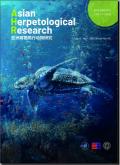Morganella morganii as a Causative Agent of Disease in the Chinese Giant Salamander (Andrias davidianus): Morganella morganii as a Causative Agent of Disease in the Chinese Giant Salamander (Andrias davidianus)
IF 1.2
3区 生物学
Q2 ZOOLOGY
引用次数: 8
Abstract
Morganella morganii is a gram-negative rod, commonly found in the environment and in the intestinal tracts of human beings and animals (O’Hara et al., 2000; Falagas et al., 2006). M. morganii is considered to be an important intensive care unit pathogen and causes fatal massive hemolysis leading to death (Singla et al., 2010). The infection of skin and soft tissue by M. morganii is very common (Falagas et al., 2006). The most frequent cause of M. morganii bacteremia is postoperative wound infection, and most infections occur in the patients who have received recent therapy with beta-lactam antibiotics. Other important epidemiological risk factors are the presence of diabetes mellitus, meningitis, septic arthritis, and so on (Falagas et al., 2006). M. morganii bacteremia frequently occurs secondarily due to urinary tract or hepatobiliary tract infection, and is associated with a high mortality, especially for those not receiving Morganella morganii as a Causative Agent of Disease in the Chinese Giant Salamander (Andrias davidianus)中华大鲵(Andrias davidianus)的致病摩根摩根菌:中华大鲵(Andrias davidianus)的致病摩根摩根菌
莫氏摩根菌是一种革兰氏阴性杆状菌,常见于环境和人类和动物的肠道中(O 'Hara et al., 2000;Falagas et al., 2006)。莫氏分枝杆菌被认为是一种重要的重症监护病房病原体,可导致致命的大量溶血导致死亡(Singla et al., 2010)。莫氏分枝杆菌对皮肤和软组织的感染非常常见(Falagas et al., 2006)。莫氏分枝杆菌菌血症最常见的原因是术后伤口感染,大多数感染发生在近期接受β -内酰胺类抗生素治疗的患者中。其他重要的流行病学危险因素是糖尿病、脑膜炎、脓毒性关节炎等(Falagas et al., 2006)。莫氏分枝杆菌菌血症经常继发于泌尿道或肝胆道感染,并与高死亡率相关,特别是对于那些没有接受莫氏分枝杆菌作为致病剂的中国大鲵(Andrias davidianus)。
本文章由计算机程序翻译,如有差异,请以英文原文为准。
求助全文
约1分钟内获得全文
求助全文
来源期刊

Asian Herpetological Research
ZOOLOGY-
CiteScore
2.80
自引率
7.10%
发文量
441
审稿时长
>12 weeks
期刊介绍:
AHR aims to provide a forum for herpetologists and related scientists interested in conducting international academic exchanges and joint studies, and a platform for introducing their newly made scientific and technological data, and publishing their research results and achievements in the world, but focusing on the Asian-Pacific Region.
The principal criteria of AHR for acceptance of articles for publication are the quality and significance of the research, breadth of interest of the work to the readership, and the clarity and effectiveness of communication. AHR welcomes submission of manuscripts from authors in all countries of the world, though with a focus on the herpetological studies in the Asian and Pacific Region, including major articles, shorter communications and review articles.
 求助内容:
求助内容: 应助结果提醒方式:
应助结果提醒方式:


